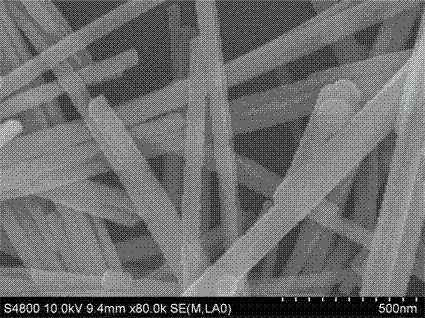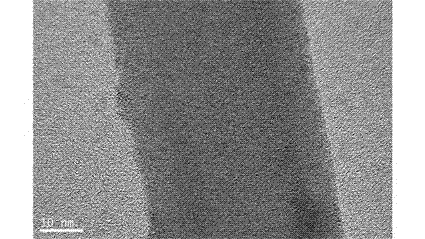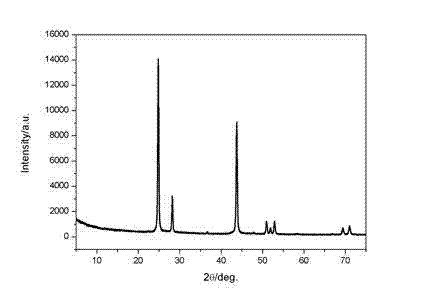One-dimensional nanometer photocatalyst as well as preparation method and application thereof
A nano-photocatalyst and catalyst technology, which is applied in the field of photocatalytic materials, can solve the problems of in-depth research on unfavorable catalyst structure regulation of structural relations and high temperature, and achieve high-efficiency photo-splitting water hydrogen production performance, simple preparation method, and high stability. Effect
- Summary
- Abstract
- Description
- Claims
- Application Information
AI Technical Summary
Problems solved by technology
Method used
Image
Examples
Embodiment 1
[0040] CdS:MoS 2 Preparation of Composite Nanophotocatalyst
[0041] (1) MoS 2 Preparation of the precursor ammonium tetrathiomolybdate (ATTM): Dissolve 0.05 mol of ammonium molybdate in 300 mL of concentrated ammonia water to prepare a saturated solution; take 21.0 mL of the saturated solution into a three-necked flask, and add 70.0 mL of ammonium sulfide solution. The reaction was carried out at 80 °C for 1 h under magnetic stirring. Cool naturally to room temperature, add ethanol to crystallize for 3 h to obtain MoS 2 Precursor ATTM.
[0042] (2) CdS precursor Cd(S 2 CNEt 2 ) 2 Preparation: 3.0805 g cadmium nitrate (Cd(NO 3 ) 2 ?4H 2 O) and 4.8094 g copper reagent (C 5 h 10 NS 2 Na?3H 2 O) Dissolve in 40 mL and 30 mL of water, then slowly add the copper reagent aqueous solution to the Cd(NO 3 ) 2 In aqueous solution, the CdS precursor Cd(S 2 CNEt 2 ) 2 .
[0043] (3) Preparation of CdS nanorods: 35 mL of ethylenediamine was added to a 50 mL autoclave, and ...
Embodiment 2
[0052] (1) MoS 2 Preparation of the precursor ammonium tetrathiomolybdate (ATTM): Dissolve 0.05 mol of ammonium molybdate in 300 mL of concentrated ammonia water to prepare a saturated solution; take 21.0 mL of the saturated solution into a three-necked flask, and add 70.0 mL of ammonium sulfide solution. The reaction was carried out at 80 °C for 1 h under magnetic stirring. Cool naturally to room temperature, add ethanol to crystallize for 3 h to obtain MoS 2 Precursor ATTM.
[0053] (2) CdS precursor Cd(S 2 CNEt 2 ) 2 Preparation: 3.0805 g cadmium nitrate (Cd(NO 3 ) 2 ?4H 2 O) and 4.8094 g copper reagent (C 5 h 10 NS 2 Na?3H 2 O) Dissolve in 40 mL and 30 mL of water, then slowly add the copper reagent aqueous solution to the Cd(NO 3 ) 2 In aqueous solution, the CdS precursor Cd(S 2 CNEt 2 ) 2 .
[0054] (3) Preparation of CdS nanorods: 35 mL of ethylenediamine was added to a 50 mL autoclave, and then 0.9872 g of Cd(S 2 CNEt 2 ) 2 , and reacted at 180 °C ...
PUM
 Login to View More
Login to View More Abstract
Description
Claims
Application Information
 Login to View More
Login to View More - R&D
- Intellectual Property
- Life Sciences
- Materials
- Tech Scout
- Unparalleled Data Quality
- Higher Quality Content
- 60% Fewer Hallucinations
Browse by: Latest US Patents, China's latest patents, Technical Efficacy Thesaurus, Application Domain, Technology Topic, Popular Technical Reports.
© 2025 PatSnap. All rights reserved.Legal|Privacy policy|Modern Slavery Act Transparency Statement|Sitemap|About US| Contact US: help@patsnap.com



